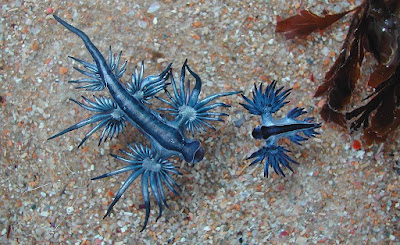kw: book reviews, nonfiction, science, oceanography, marine biology
The Blue Sea Dragon is a beautiful creature, a type of sea slug. You wouldn't want to handle one, in spite of their tiny size, around 3 cm at most (1¼"). They are armed with stinging cells similar to those of the Portuguese Man of War, which they obtain by eating small animals related to the Man of War and "appropriating" their stingers!They are rather rare, found at or near the surface of warm oceans. This Wikipedia article has much more about them. They are also described on pages 147-148 of Into the Great Wide Ocean: Life in the Least Known Habitat on Earth by Sönke Johnsen, where they are presented as an example of small pelagic animals that avoid being eaten by being, not just noxious, but venomous. Sea slugs in general are tasty treats for many oceanic predators. Not these!
"Pelagic" is from a classical Greek word meaning "of the open ocean." By definition the pelagic zone is nearly all of the world ocean, all of the salt water that is far enough from the coast to be unaffected by surf action and is also above the bottom (by a rather poorly defined distance; at least several meters). The upper kilometer of this is of special interest to Dr. Johnsen, being the zone in which at least a little sunlight penetrates, making photosynthesis possible, and also making sight hunting possible.
The book is part memoir, part travelogue, and part catalogue, a catalogue of the attributes needed by the animals that live in the upper pelagic zone, never approaching land or the sea bottom…at least not voluntarily. The book is illustrated by Marlin Peterson; his depiction of the sea dragon, Glaucus atlanticus, is shown here for comparison with the photo above.To study pelagic creatures is costly and difficult. Operating an oceangoing ship costs thousands of dollars daily, and the extra crew needed to handle a submersible or an ROV, or both, must be paid, and such equipment is worth millions. So, a dozen scientists and a couple of dozen crew may spend half a month of a month at sea, and get a smattering of photos via the ROV or in a submersible, but sometimes they return without sighting anything at all!
A large majority of pelagic animals avoid being seen by being transparent. The author writes of being on "blue water" SCUBA dives, knowing that thousands of finger-sized salps are all around, and seeing nothing. Animals that are not transparent are typically counter-shaded, and those that reside a little deeper down, where there is no upward-welling light to reflect off a silvery ventral side, have arrays of controllable bioluminescent organs that make their underside match the light coming from above. The "arms race" between predators that don't want prey to see them, and prey that don't want predators to see them, makes them hard to detect, even by each other! Thus, many can also shine their own bioluminescent flashlights to find a mate, for example, at the risk of attracting a predator.
Past knowledge of mid-oceanic life was gathered by trawling. One may thus learn of the existence of numerous animals, at least the slower ones. Not many oceanic squid, for example, are brought up by trawling. The fragile beings caught in a trawl usually arrive as clumps of unidentifiable sludge. By analogy, imagine studying London by dragging an anchor on a chain from a fast dirigible, to try to learn how the British live. More useful and appropriate methods are continually being devised.
An interesting contrast is presented in a section on Navigation. A pair of scientists the author knows uses a large, boxy tank surrounded by electromagnets to test juvenile sea turtles. They appear to have a magnetic sense, which helps the females navigate to their favored beach for laying their eggs, for example. Now consider elephant seals. The females come ashore to meet their mates, give birth, mate again a month later, then head out to sea. It is known that they travel thousands of kilometers to good feeding grounds, then return to land to give birth. It is also known that they swim a couple of hundred feet down (50-80 meters), so they can't be navigating by the stars. But a female elephant seal weighs a ton, and though she is less fearsome than her four-ton mate, she is still more dangerous than the average lion. You aren't going to get one of these in a magnet-bounded tank! As the author writes, with better-than-average scientific humility, he and others have studied elephant seal navigation for several years, and so far have learned nothing!
Such studies would be so much simpler if these animals—at least the smaller ones—could be brought into the laboratory and "put through their paces." But animals in the lab may not exhibit any of their in-the-wild behaviors, and the things they might do in a tank are likely to bear no resemblance to what they do in the open ocean. Scientists labor to devise more clever and less intrusive instruments, hoping to observe natural and normal behavior. Really, the study of this immense habitat, that covers 70% of the surface of the Earth, has just begun.





No comments:
Post a Comment